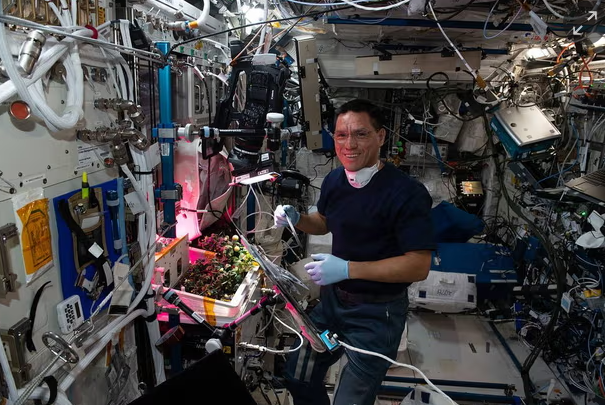The Case of the Missing Space Tomatoes

On September 27, 2023, Frank Rubio, pictured above, set an American record by coming home. Rubio, an astronaut, had spent the last 371 days in space, all of it (except for the transit) on the International Space Station. That’s the longest spaceflight by any American and something Rubio is certainly proud of.
But his reputation aboard the ISS wasn’t quite clean when he landed. Because — jokingly, mostly — he was accused of theft. Specifically, his fellow astronauts wondered if he had eaten one of humanity’s first space tomatoes.
One of the problems with being in space is that people, even astronauts, need food, but it’s not so easy to get food to space. We can send it on rockets to the ISS, sure, but if we want to explore being a multiplanet species, we’ll need to find a way to make food while not on Earth. So NASA embarked on an experiment, officially called “Pick-and-Eat Salad-Crop Productivity, Nutritional Value, and Acceptability to Supplement the ISS Food System” but more commonly called the much simpler name of “Veg-05.” As the agency explained, a “healthy, nutritious diet is essential for long-duration exploration missions, which means that the typical pre-packaged astronaut diet may need to be supplemented by fresh foods during flight.” Growing vegetables is a good way to do that — if you can figure out how to grow vegetables in space.
On March 29, 2023, as seen in the image at the top, Rubio harvested the first food from the Veg-05 experiment. (You can watch a stop-motion video of him in action on Twitter/X, here.) The astronauts were growing small tomatoes known as dwarf tomatoes, and as seen in that video, Rubio cut the vegetables from the vine and placed them into Ziploc bags. The tomatoes weren’t supposed to be eaten aboard the ISS, but rather sent to Earth for analysis — as Food and Wine explains, “the astronauts were allowed to examine them, but could not eat them due to the potential for fungal contamination” — but that didn’t quite go to plan. Shortly after Rubio harvested the fruits, one baggie went missing.
Six months later, Rubio told his side of the story to NASA in his post-flight interview, which you can watch here. Per Rubio, he harvested the tomatoes and placed them into a baggie as planned, but one of his colleagues was on a video call with a classroom full of school kids. Rubio kindly joined the call to show the kids the first tomato ever grown in space and then Ziplocked the bag to the wall (as he was supposed to do) afterward — or so he thought. When he went back to check on the tomato later, it wasn’t where it should’ve been. In fact, it was missing entirely. As reports of the missing tomato spread, per Rubio, accusations (again, mostly in jest) that he had eaten the vegetable began picking up steam.
Rubio searched the ISS — about the size of a very large house, but of course, you can’t (easily) go outside — for as much as 20 hours, hoping to silence his accusers. But he came up empty. And to make things worse, by the time he returned to Earth, Rubio was convinced that the tomato would never be found. The humidity in the ISS, he speculated, would cause the fruit to decompose; at some point, someone probably threw out the bag assuming it was just trash.
But in December of 2023, a few months after Rubio returned to Earth, he was exonerated. On December 14th, NASA announced that the tomatoes — yes, plural — had been discovered: “While celebrating the space station’s 25th anniversary of operations, Expedition 70 crew members revealed they found the lost tomatoes, joking that Rubio did not eat the tomatoes as they suspected. Despite being nearly a year after the initial disappearance of the tomatoes, the fruit was found in a plastic bag dehydrated and slightly squished. Other than some discoloration, it had no visible microbial or fungal growth.” You can see a picture of the two tomatoes in their bag at that link, and as you can see, they’re small, squished, and not very appetizing-looking. But at least they were found.
Bonus fact: In 1988, the Scottish duo The Proclaimers released the song “I’m Gonna Be (500 Miles).” The song really is about a guy who travels 1,000 miles — the chorus states “But I would walk five hundred miles / And I would walk five hundred more / Just to be the man who walked a thousand miles to fall down at your door.” Officially, the song is 3 minutes and 37 seconds long, but the official video runs 3:30. What does this have to do with… well, anything above? The International Space Station travels at a speed of about 7.66 kilometers per second. Randall Munroe, author of xkcd and what-if, made a fantastic discovery: “The song’s length leads to an odd coincidence. The interval between the start and the end of I’m Gonna Be is 3 minutes and 30 seconds, and the ISS is moving at 7.66 km/s. This means that if an astronaut on the ISS listens to I’m Gonna Be, in the time between the first beat of the song and the final lines, they will have traveled just about exactly 1,000 miles.”
From the Archives: Fruits and Vegetables (and Prank Callers, Too!): Are tomatoes a fruit or a vegetable? According to the U.S. Supreme Court, they’re both — depending on the context.
